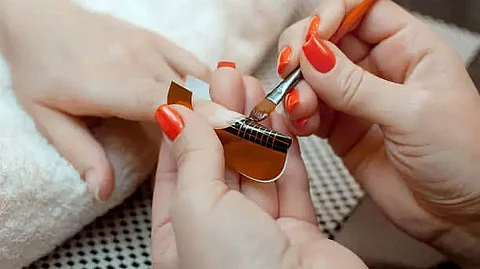
- Home
- Live Blog
- Breaking News
- Top Headlines
- Cities
- NE News
- Sentinel Media
- Sports
- Education
- Jobs

Gel nail extensions have become one of the most popular nail enhancement techniques, offering a durable, lightweight, and natural-looking alternative to acrylic nails. These extensions provide length and strength to natural nails using hard gel, which is cured under UV or LED light.
Whether you're looking for long, sturdy nails or a stylish manicure that lasts for weeks, gel extensions are a top choice. However, like any beauty treatment, they come with both benefits and drawbacks. This article will explore everything you need to know about gel nail extensions, including how they are applied, their longevity, and the correct removal process.
Gel nail extensions are artificial nail enhancements created using a hard gel that is cured under a UV or LED lamp. To extend the nail length, a nail technician applies a nail form—a sticker that fits beneath the nail tip—or a pre-formed soft gel tip that is adhered to the natural nail using gel. These tips come in various sizes and shapes to suit different nail styles.
Many people opt for gel extensions because they provide the appearance of long, strong nails without the use of acrylics, which can be damaging. Unlike traditional acrylics, gel extensions are lightweight and more flexible, reducing the risk of breakage.
However, to apply gel extensions, the natural nail must have a slight length—a completely short nail may not hold the extension properly.
Lightweight: Unlike acrylic nails, gel extensions feel natural and are not heavy.
Sturdy and Durable: When applied correctly, they last up to four weeks without chipping or breaking.
Easier Removal Process: Compared to acrylics, gel extensions have a simpler and safer removal method.
Less Damaging Than Acrylics: Gel does not contain harsh chemicals like methyl methacrylate, making it a safer option for nail health.
Potential Nail Damage: If removed improperly, gel extensions can weaken and thin the natural nail.
Not Suitable for Very Short Nails: Since the gel extension needs a base to adhere to, extremely short nails may not support them.
Expensive: Depending on the salon and location, gel extensions can be costly, especially if special colors or intricate nail art are requested.
Before applying extensions, the nail technician will:
✔️ File and shape the natural nails
✔️ Clean and buff the nail surface
✔️ Remove excess oils and dirt
A primer and bonder are applied to make the nails sticky and dry. This ensures better adhesion of the gel to the natural nail.
The technician selects the correct size gel tip for each nail.
A layer of gel is applied inside the extension.
The extension is pressed onto the natural nail and held in place.
The nails are cured under a UV or LED light for 60 seconds.
After curing, the extensions are shaped and filed. A gel top coat is applied and cured again under the UV light. At this stage, you can opt for nail polish or custom nail art.
Feature Gel Nail Extensions Acrylic Nails Material Hard gel Liquid monomer & polymer powder Flexibility More flexible, reducing breakage Hard and rigid Removal Process Soaked off with acetone Requires filing and soaking Odor Odorless Strong chemical smell Durability Lasts 2-4 weeks Lasts 3-6 weeks Damage to Natural Nail Less damaging if removed properly More damaging over time
Acrylic nails are harder and more durable but can be damaging due to the chemicals used. Gel extensions, on the other hand, are more natural-looking and easier to remove.
Gel extensions typically last between two to five weeks, depending on how well they are maintained and how often hands are used for daily activities.
If you frequently use your hands for tasks like typing, cooking, or cleaning, your extensions may last closer to two weeks.
If you are gentle with your nails and take proper care, they may last up to five weeks.
A fill-in may be required every two to three weeks to maintain the appearance and health of the extensions.
Improper removal of gel extensions can cause significant nail damage. To avoid thinning and weakening your nails, it is recommended to have them removed by a professional.
The technician files down 85% of the gel extension.
The remaining gel is soaked in acetone for 15 minutes.
The softened gel is gently pushed off using a cuticle pusher.
The natural nail is buffed and moisturized to restore health.
The entire process takes about 30 to 40 minutes and ensures minimal damage to the natural nail.
If you must remove them at home:
✔️ File down the top layer carefully.
✔️ Soak nails in acetone using cotton pads and aluminum foil.
✔️ Gently scrape off softened gel—do not force it!
✔️ Apply cuticle oil and moisturizer after removal.
Gel extensions are safe as long as they are:
✅ Applied correctly by a trained professional.
✅ Removed properly without excessive filing or force.
✅ Given time to breathe between applications to prevent nail thinning.
Unlike acrylics, gel extensions do not contain harsh chemicals like toluene or methyl methacrylate, making them a healthier option.
Gel nail extensions are a fantastic alternative to acrylics, offering long-lasting, lightweight, and elegant nails. Whether you prefer a natural look or bold nail art, they provide versatility and style.
While they can be costly and require professional maintenance, their flexibility and ease of removal make them a preferred choice for many. If you decide to try gel extensions, ensure they are applied and removed correctly to keep your natural nails healthy.
Also Read: Packing for a Beach Visit
Also Watch: